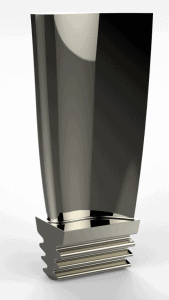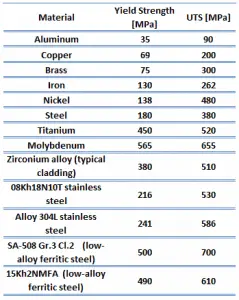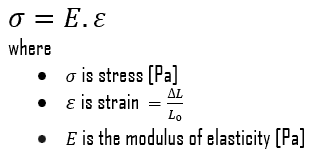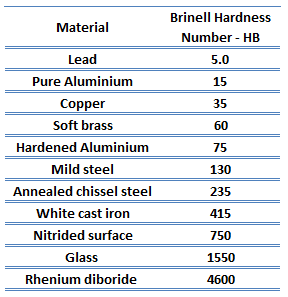Nickel is a silvery-white lustrous metal with a slight golden tinge, and nickel is one of the most common alloying elements. About 65% of nickel production is used in stainless steel. Because nickel does not form any carbide compounds in steel, it remains in solution in the ferrite, thus strengthening and toughening the ferrite phase. Nickel steels are easily heat treated because nickel lowers the critical cooling rate.
Nickel-based alloys (e.g., Fe-Cr-Ni(Mo) alloys) alloys exhibit excellent ductility and toughness, even at high strength levels and these properties are retained up to low temperatures. Nickel and its alloys are highly resistant to corrosion in many environments, especially those that are basic (alkaline). Nickel also reduces thermal expansion for better dimensional stability. Nickel is the base element for superalloys. These metals have excellent resistance to thermal creep deformation and retain their stiffness, strength, toughness, and dimensional stability at temperatures much higher than the other aerospace structural materials.
Types of Nickel Alloys
Nickel-based Superalloys
 Nickel-base superalloys currently constitute over 50% of the weight of advanced aircraft engines. Nickel-based superalloys include solid-solution-strengthened alloys and age-hardenable alloys. Age-hardenable alloys consist of an austenitic (fcc) matrix dispersed with coherent precipitation of a Ni3(Al, Ti) intermetallic with an fcc structure. Ni-based superalloys are alloys with nickel as the primary alloying element and is preferred as blade material in the previously discussed applications, rather than Co- or Fe-based superalloys. Ni-based superalloys are significant for their high strength, creep, and corrosion resistance at high temperatures. It is common to cast turbine blades in directionally solidified form or single-crystal form. Single-crystal blades are mainly used in the first row of the turbine stage.
Nickel-base superalloys currently constitute over 50% of the weight of advanced aircraft engines. Nickel-based superalloys include solid-solution-strengthened alloys and age-hardenable alloys. Age-hardenable alloys consist of an austenitic (fcc) matrix dispersed with coherent precipitation of a Ni3(Al, Ti) intermetallic with an fcc structure. Ni-based superalloys are alloys with nickel as the primary alloying element and is preferred as blade material in the previously discussed applications, rather than Co- or Fe-based superalloys. Ni-based superalloys are significant for their high strength, creep, and corrosion resistance at high temperatures. It is common to cast turbine blades in directionally solidified form or single-crystal form. Single-crystal blades are mainly used in the first row of the turbine stage.
For example, Inconel is a registered trademark of Special Metals for a family of austenitic nickel-chromium-based superalloys. Inconel 718 is a nickel-based superalloy that possesses high strength properties and resistance to elevated temperatures. It also demonstrates remarkable protection against corrosion and oxidation. Inconel’s high-temperature strength is developed by solid solution strengthening or precipitation hardening, depending on the alloy. Inconel 718 is composed of 55% nickel, 21% chromium, 6% iron, and small amounts of manganese, carbon, and copper.
Nickel Silver
Nickel silver, also known as German silver, nickel brass, or alpaca, is a copper alloy with nickel and often zinc. For example, UNS C75700 nickel silver 65-12 copper alloy has good corrosion and tarnish resistance and high formability. Nickel silver is named due to its silvery appearance, but it contains no elemental silver unless plated.
Constantan
Constantan is a copper-nickel alloy usually consisting of 55% copper and 45% nickel and specific minor amounts of additional elements to achieve precisely (almost constant) values for the temperature coefficient of resistivity. That means its main feature is the low thermal variation of its resistivity, which is constant over a wide range of temperatures. Other alloys with similarly low-temperature coefficients are known, such as manganin.
This alloy has high electrical resistivity (4.9 x 10−7 Ω·m), high enough to achieve suitable resistance values in even very small grids, the lowest temperature coefficient of resistance, and the highest thermal EMF (also known as the Seebeck effect) against platinum of any of the copper-nickel alloys. Because of the first two of these properties, it is used for electrical resistors and thermocouples because of the latter property. Thermocouples are electrical devices consisting of two dissimilar electrical conductors forming an electrical junction. A thermocouple produces a temperature-dependent voltage due to the thermoelectric effect, which can be interpreted to measure temperature.
For example, constantan is the negative element of the type J thermocouple with iron being positive. The type J thermocouples are used in heat-treating applications. Also, Constantan is the negative element of the type T thermocouple with copper the positive. These thermocouples are used at cryogenic temperatures.
In nuclear reactors, the thermocouples are positioned at preselected locations to measure fuel assembly coolant outlet temperature for use in monitoring the core radial power sharing and coolant. But in this case, thermocouples must withstand neutron irradiation, thus, type E (chromel-alumel), or other special thermocouples are preferred.
Invar
Invar is a group of low thermal expansion nickel-iron alloys consisting primarily of nickel and iron (e.g., FeNi36). The name Invar comes from the wordInvarriable, referring to its relative lack of expansion or contraction with temperature changes. The Invar alloy is ductile and easily weldable, and machinability is similar to austenitic stainless steel.
Invar is used where high dimensional stability is required, such as precision instruments, and clocks. Alloys with low coefficients of expansion form the essential part of bimetals and thermostats. Invar itself is still used in many household appliances, from electric irons and toasters to gas cookers and fire safety cutoffs. Invars can also be used in glass-to-metal seals and electronic and radio components. Almost all variable condensers are made of Invar. Struts on jet engines are made ofInvarr to ensure rigidity with temperaturInvarnges.
Properties of Nickel Alloys
Material properties are intensive properties, which means they are independent of the amount of mass and may vary from place to place within the system at any moment. Materials science involves studying materials’ structure and relating them to their properties (mechanical, electrical, etc.). Once materials scientist knows about this structure-property correlation, they can then go on to study the relative performance of a material in a given application. The major determinants of the structure of a material and, thus, its properties are its constituent chemical elements and the way it has been processed into its final form.
Mechanical Properties of Nickel Alloys
Materials are frequently chosen for various applications because they have desirable combinations of mechanical characteristics. For structural applications, material properties are crucial, and engineers must take them into account.
Strength of Nickel Alloys
In the mechanics of materials, the strength of a material is its ability to withstand an applied load without failure or plastic deformation. The strength of materials considers the relationship between the external loads applied to a material and the resulting deformation or change in material dimensions. The strength of a material is its ability to withstand this applied load without failure or plastic deformation.
Ultimate Tensile Strength
The ultimate tensile strength of constantan – 45Ni-55Cu depends greatly on the heat treatment procedure, but for the annealed alloy is about 420 MPa.
 The ultimate tensile strength is the maximum on the engineering stress-strain curve. This corresponds to the maximum stress that can be sustained by a structure in tension. Ultimate tensile strength is often shortened to “tensile strength” or even to “the ultimate.” If this stress is applied and maintained, the fracture will result. Often, this value is significantly more than the yield stress (as much as 50 to 60 percent more than the yield for some types of metals). When a ductile material reaches its ultimate strength, it experiences necking where the cross-sectional area reduces locally. The stress-strain curve contains no higher stress than the ultimate strength. Even though deformations can continue to increase, the stress usually decreases after achieving the ultimate strength. It is an intensive property; therefore its value does not depend on the size of the test specimen. However, it is dependent on other factors, such as the preparation of the specimen, the presence or otherwise of surface defects, and the temperature of the test environment and material. Ultimate tensile strengths vary from 50 MPa for aluminum to as high as 3000 MPa for very high-strength steels.
The ultimate tensile strength is the maximum on the engineering stress-strain curve. This corresponds to the maximum stress that can be sustained by a structure in tension. Ultimate tensile strength is often shortened to “tensile strength” or even to “the ultimate.” If this stress is applied and maintained, the fracture will result. Often, this value is significantly more than the yield stress (as much as 50 to 60 percent more than the yield for some types of metals). When a ductile material reaches its ultimate strength, it experiences necking where the cross-sectional area reduces locally. The stress-strain curve contains no higher stress than the ultimate strength. Even though deformations can continue to increase, the stress usually decreases after achieving the ultimate strength. It is an intensive property; therefore its value does not depend on the size of the test specimen. However, it is dependent on other factors, such as the preparation of the specimen, the presence or otherwise of surface defects, and the temperature of the test environment and material. Ultimate tensile strengths vary from 50 MPa for aluminum to as high as 3000 MPa for very high-strength steels.
Yield Strength
The yield strength of constantan – 45Ni-55Cu depends greatly on the heat treatment procedure, but for the annealed alloy is about 150 MPa.
The yield point is the point on a stress-strain curve that indicates the limit of elastic behavior and the beginning plastic behavior. Yield strength or yield stress is the material property defined as the stress at which a material begins to deform plastically. In contrast, the yield point is where nonlinear (elastic + plastic) deformation begins. Before the yield point, the material will deform elastically and return to its original shape when the applied stress is removed. Once the yield point is passed, some fraction of the deformation will be permanent and non-reversible. Some steels and other materials exhibit a behavior termed a yield point phenomenon. Yield strengths vary from 35 MPa for low-strength aluminum to greater than 1400 MPa for very high-strength steel.
Young’s Modulus of Elasticity
Young’s modulus of elasticity of constantan – 45Ni-55Cu is about 162 GPa.
Young’s modulus of elasticity is the elastic modulus for tensile and compressive stress in the linear elasticity regime of a uniaxial deformation and is usually assessed by tensile tests. Up to limiting stress, a body will be able to recover its dimensions on the removal of the load. The applied stresses cause the atoms in a crystal to move from their equilibrium position. All the atoms are displaced the same amount and still maintain their relative geometry. When the stresses are removed, all the atoms return to their original positions, and no permanent deformation occurs. According to Hooke’s law, the stress is proportional to the strain (in the elastic region), and the slope is Young’s modulus. Young’s modulus is equal to the longitudinal stress divided by the strain.
The hardness of Nickel Alloys
Rockwell hardness of constantan – 45Ni-55Cu is approximately 50 HRB.
Rockwell hardness test is one of the most common indentation hardness tests, that has been developed for hardness testing. In contrast to the Brinell test, the Rockwell tester measures the depth of penetration of an indenter under a large load (major load) compared to the penetration made by a preload (minor load). The minor load establishes the zero position. The major load is applied and removed while maintaining the minor load. The difference between the depth of penetration before and after the application of the major load is used to calculate the Rockwell hardness number. That is, the penetration depth and hardness are inversely proportional. The chief advantage of Rockwell hardness is its ability to display hardness values directly. The result is a dimensionless number noted as HRA, HRB, HRC, etc., where the last letter is the respective Rockwell scale.
The Rockwell C test is performed with a Brale penetrator (120°diamond cone) and a major load of 150kg.
Thermal Properties of Nickel Alloys
Thermal properties of materials refer to the response of materials to changes in their temperature and the application of heat. As a solid absorbs energy in the form of heat, its temperature rises, and its dimensions increase. But different materials react to the application of heat differently.
Heat capacity, thermal expansion, and thermal conductivity are often critical in solids’ practical use.
Melting Point of Nickel Alloys
The melting point of constantan – 45Ni-55Cu is around 1210°C.
In general, melting is a phase change of a substance from the solid to the liquid phase. The melting point of a substance is the temperature at which this phase change occurs. The melting point also defines a condition in which the solid and liquid can exist in equilibrium.
Thermal Conductivity of Nickel Alloys
The thermal conductivity of constantan – 45Ni-55Cu is 21 W/(m. K).
The heat transfer characteristics of solid material are measured by a property called the thermal conductivity, k (or λ), measured in W/m.K. It is a measure of a substance’s ability to transfer heat through a material by conduction. Note that Fourier’s law applies to all matter, regardless of its state (solid, liquid, or gas), therefore, it is also defined for liquids and gases.
The thermal conductivity of most liquids and solids varies with temperature. For vapors, it also depends upon pressure. In general:
Most materials are very nearly homogeneous, therefore, we can usually write k = k (T). Similar definitions are associated with thermal conductivities in the y- and z-directions (ky, kz), but for an isotropic material the thermal conductivity is independent of the direction of transfer, kx = ky = kz = k.
Temperature Coefficient of Resistance of Constantan
The temperature coefficient of resistance (TCR), which describes how much its value changes as its temperature changes, of constantan – 45Ni-55Cu is ± 30 ppm/°C. It is usually expressed in ppm/°C (parts per million per degree Centigrade) units.
Thermal Expansion Coefficient of Constantan
The linear coefficient of thermal expansion of constantan at 25 to 105°C is 14.9 x 10-6 K-1.
Linear coefficient of thermal expansion of invar – FeNi36 at 25 to 105°C is about 1.2 x 10-6 K-1 (1.2 ppm/°C).
Thermal expansion is gInvarlly the tendency of matter to change its dimensions in response to a change in temperature. It is usually expressed as a fractional change in length or volume per unit temperature change. Thermal expansion is common for solids, liquids, and gases. Unlike gases or liquids, solid materials tend to keep their shape when undergoing thermal expansion. A linear expansion coefficient is usually employed in describing the expansion of a solid, while a volume expansion coefficient is more useful for a liquid or a gas.
The linear thermal expansion coefficient is defined as:
where L is a particular length measurement and dL/dT is the rate of change of that linear dimension per unit change in temperature.
Electrical Resistivity of Constantan
Electrical resistivity of constantan – 45Ni-55Cu is 4.9 x 10−7 Ω·m, high enough to achieve suitable resistance values in even very small grids.
Electrical resistivity and its converse, electrical conductivity, is a fundamental property of a material that quantifies how strongly it resists or conducts the flow of electric current. A low resistivity indicates a material that readily allows the flow of electric current. The symbol of resistivity is usually the Greek letter ρ (rho). The SI unit of electrical resistivity is the ohm-meter (Ω⋅m). Note that electrical resistivity is not the same as electrical resistance. Electrical resistance is expressed in Ohms. While resistivity is a material property, resistance is the property of an object.





